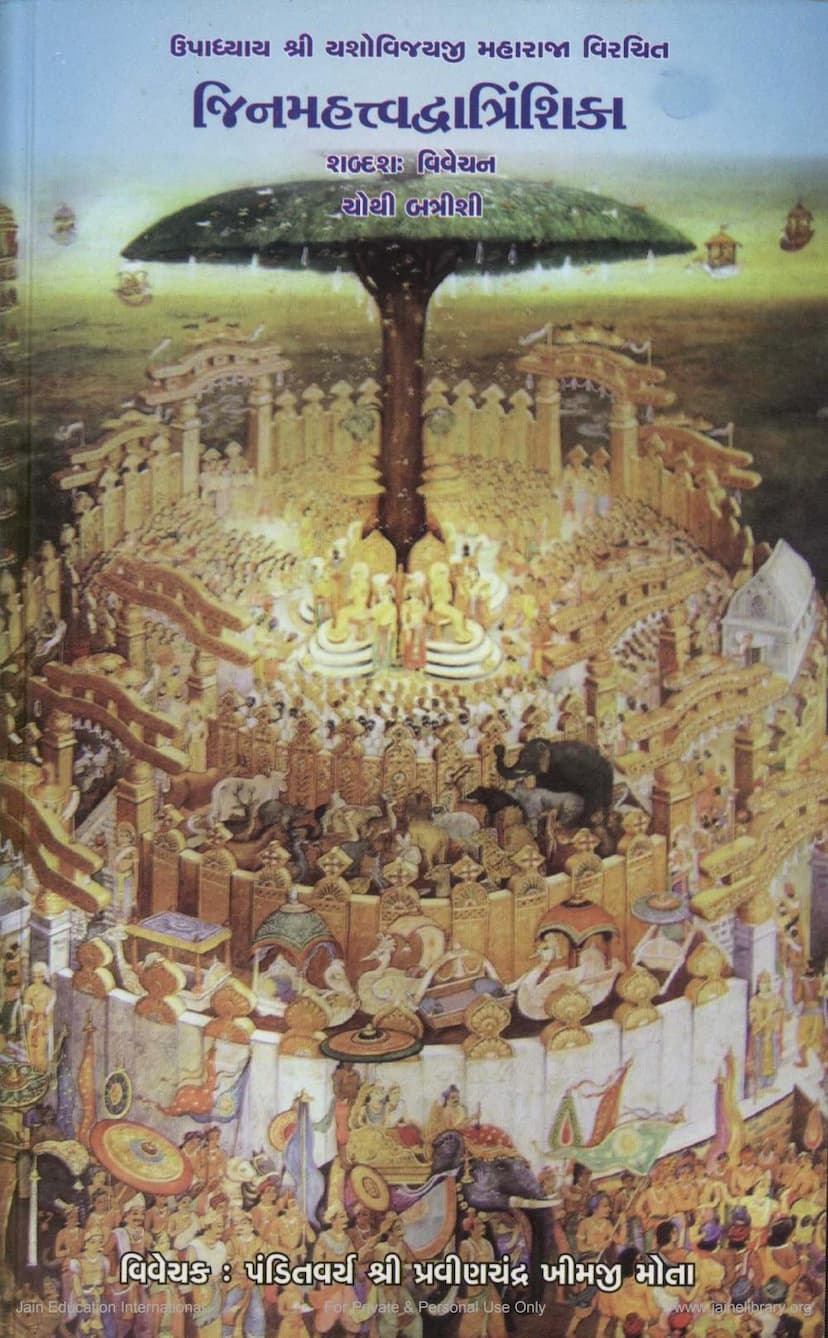Jina Mahattva Dvantrinshika
Added to library: September 2, 2025
Loading image...

Summary
This document is the colophon and introductory material for the Gujarati commentary on the Jain text "Jina Mahattva Dvatrinshika" by Upadhyay Yashovijayji, with commentary by Pandit Pravinchandra Khimji Mota.
Here's a breakdown of the key information:
- Title: Jina Mahattva Dvatrinshika Shabdashah Vivechan (જિનમહત્ત્વદ્ધાત્રિશિકા શબ્દશઃ વિવેચન) - This indicates a word-by-word commentary on the "Jina Mahattva Dvatrinshika."
- Original Author: Mahamahopadhyaya Shrimad Yashovijayji Maharaj (મહામહોપાધ્યાય શ્રીમદ્ યશોવિજયજી મહારાજા) - He is the author of the original work, which is part of the "Dvatrimshad Dvatrimshika" (દ્વાચિંશદ્વાચિંશિકા) treatise.
- Commentator (Vivechak): Panditvar Shri Pravinchandra Khimji Mota (પંડિતવર્ય શ્રી પ્રવીણચંદ્ર ખીમજી મોતા).
- Publisher: Gitarth Ganga (ગીતાર્થ ગંગા).
- Edition: First edition, published in Veer Samvat 2533 (approx. 1977 CE) and Vikram Samvat 2013 (which seems incorrect given the Veer Samvat). The price is Rs. 50.00.
- Financial Support: Palviya Parshvanath Jain Sangh, Palanpur (પલવીયા પાર્શ્વનાથ જૈન સંઘ, પાલનપુર).
- Key Figures/Blessings: The publication acknowledges the blessings of Acharyadevesh Shrimad Vijay Ramchandrasurishwarji Maharaj, Munipravar Shrimad Mohjitvijayji Maharaj, and Ganivarya Shrimad Yugbhushanvijayji Maharaj. It also credits Sadhvi Bodhiratnashriji for the compilation and research.
- Content of Jina Mahattva Dvatrinshika: The introduction on page 10 explains that the original text, composed of 32 verses on 32 topics, is a masterpiece by Yashovijayji. The "Jina Mahattva Dvatrinshika" specifically discusses how Lord Jineshwar (the Jinas) are superior to other deities, using arguments and logic from Jain and other philosophical schools.
- Arguments for Jina's Greatness (Summary from pages 11-13):
- Internal Qualities: Greatness comes from inner virtues, truthful and consistent speech, and qualities like omniscience.
- External Aspects: This includes the divine physique with 1008 auspicious marks, ideal mind-speech-body activities, and external grandeur.
- Innate Nature: Even in states of ignorance, the innate purity and potential for welfare of the Jinas set them apart.
- Overcoming Flaws: The Jinas are great because they have conquered all flaws and become pure through their own efforts, unlike philosophers from other traditions who may have flaws.
- Knowledge: The Jinas are great because they are the knowers of all substances, and no substance operates beyond their knowledge.
- Non-Creator Role: The Jinas are great precisely because they are not the creators of the universe.
- Comparisons with other figures: The text systematically refutes claims of greatness made by other traditions for their respective deities, showing how the Jinas surpass them in various aspects (e.g., comparing Jain Tirthankaras to Bodhisattvas in Buddhism, highlighting the purity and effort involved).
- Core Message: The ultimate message emphasizes that the Jina (Arhat) is worthy of worship, remembrance, and service. Devotion to the Jina's teachings (Shasan) is paramount for spiritual progress. The text draws parallels to how an insect transforms into a bee through constant contemplation.
- Commentary's Purpose: The commentary by Pandit Pravinchandra Mota aims to explain these deep meanings clearly, making the profound "Dvatrinshika" accessible.
- Publisher's Goal (Gitarth Ganga): The publisher's aim is to analyze and present the profound elements found in Jain scriptures by great acharyas like Haribhadrasuri and Yashovijayji, to aid the Jain community in comprehensive understanding. They also publish lectures and critical analyses by scholars like Muni Mohjitvijayji and Pandit Pravinchandra Mota due to popular demand.
In essence, the document is about a detailed, scholarly commentary on a key Jain text that establishes the supreme greatness of the Jinas based on their unique internal and external qualities, their victory over karma, their profound knowledge, and their unerring teachings, contrasting them with other spiritual figures and philosophical concepts.